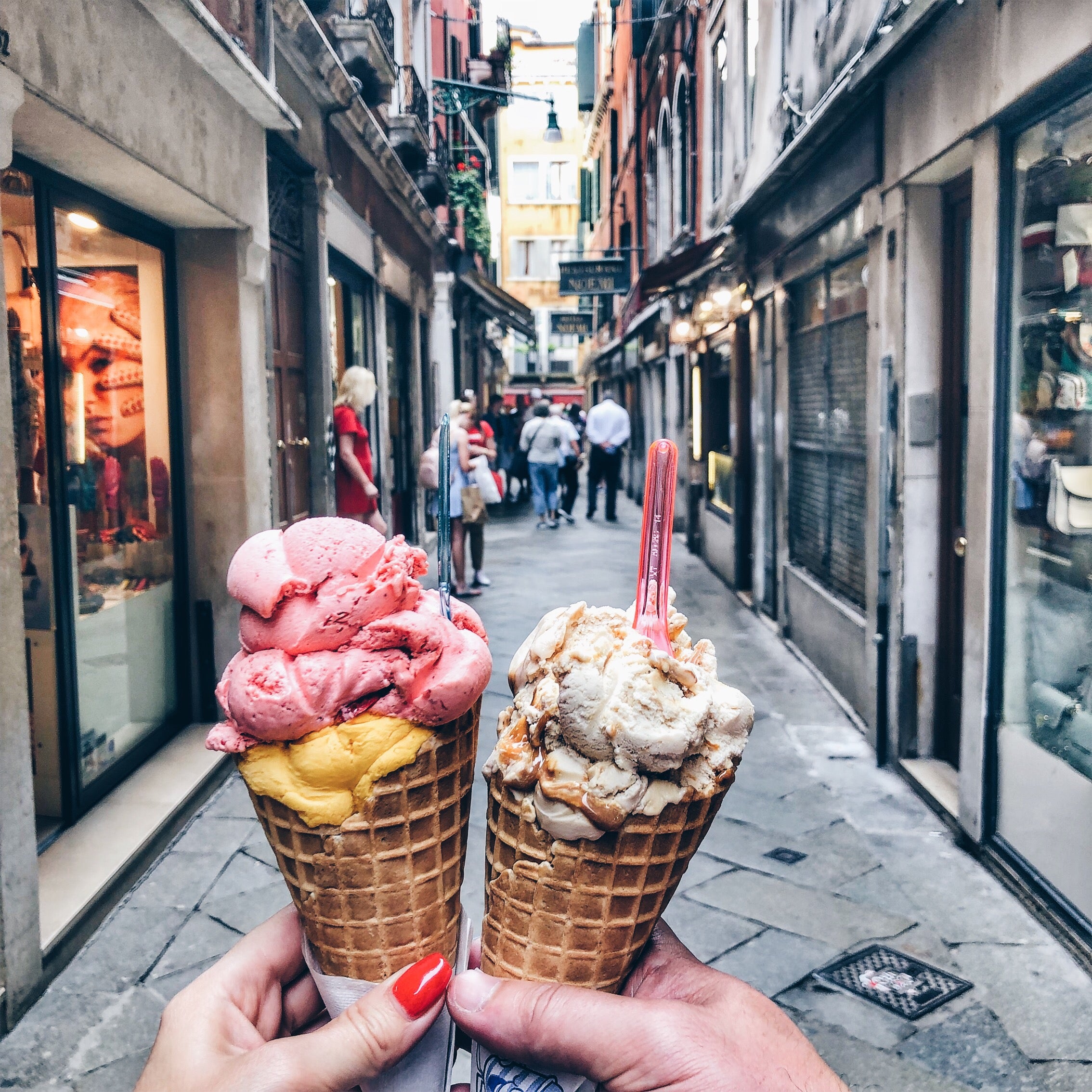"Paris is always a good idea" said Audrey Hepburn once and it is indeed a perfect motto for this enchanting place. There is no better city for a romantic weekend getaway. Couples from all over the world flock to the City of Lights to stroll along its romantic architecturally stunning streets, dine in candle light at one of its chic eateries and explore its history through a multitude of well-preserved historical sights.
But with so much to see and do, how does one see all the main sights in one weekend and still have time to enjoy each other's company? No worries, we've got you covered! With dozens of trips under our belt we are sharing our time-tested itinerary designed to turn your short time in Paris into a beautiful memory you will cherish forever. So grab your passports, jump on the plane and enjoy.
Arrival in Paris & Day 1 Afternoon Walk
Charles de Gaulle airport is well-connected to Paris by train. Follow the signs to the RER train as you exit baggage claim, buy round-trip tickets and hop on the express train that will drop you off in the center of Paris from where you can take the métro and reach your hotel in a jiffy.
Traveler's Tip: don't forget to take your ticket with you after you enter the airport RER station, you will need it to exit the train station at your destination.
Since we are dream-traveling from the U.S., you arrived to Paris in the morning. Once you found your hotel and checked in (if you arrived before check-in and your room is not ready yet, you can always leave your luggage with the bell boy so that you don't have to lug it around with you), you are ready to start your Parisian adventure.
Traveler's Tip: if you want to make your Parisian adventure even more romantic, grab one of our compact Starter or Essential romance decor boxes and stash them in your suitcase. While your honey takes a shower, order a bottle of champagne and transform your hotel room into a perfect romantic oasis in minutes.
To start the 2 / 3-hour walk, take the métro to the École Militaire station in the 7th district. If you are ready for a bite, pop into the medieval Rue Cler. Here, you will find an abundance of cafes serving breakfast and lunch in a picturesque typically Parisian setting. Another option for lunch or dinner here is the locals' favorite - 7eme Vin at 68 Avenue Bosquet.
Then, head toward Champ de Mars. As you enter the gigantic park, marvel at the original Iron Lady towering over the city all the way across the park. As you make your way through hundreds of tourists taking pictures with the world's most famous background, beware of pickpockets. Walk under the Tower paying attention to its exquisite architectural design. If you want (and have purchased the tickets waaaaay in advance), you can take an elevator to the top of the Tower, but since we are on tight schedule, it's an easily skippable sight.
Right before you cross the Seine, check out Paris' famous Carrousel de la Tour Eiffel, a perfect backdrop for yet another picture of the Eiffel Tower. Admire the impressive equestrian warrior statues flanking the sides of the old bridge you are about to cross. Once you are inside yet another large park, Jardins du Trocadéro, head straight and climb the stairs to Place du Trocadéro, a large elevated square with amazing views. As you make your way through yet another horde of tourists, notice the beautiful golden gilded statues at the Palais Chaillot.
Bear right at the enormous Trocadéro round-about and start walking north along Avenue Kléber towards Arc de Triomphe.
This street is a typical representation of Paris being a big city. Lined with beautiful buildings and picturesque hotels (notice the flower-adorned Hotel Baltimore on the left side of the street) your walk takes you all the way to Paris' second most famous sight - Arc de Triomphe.
Dining Tip: L’Oseau Blanc - one of the most romantic restaurants in Paris with a terrific view of the Eiffel Tower is located on this street inside the Peninsula Paris hotel. Reservations are a must and should be made way in advance.
The Arch was built to commemorate those who fought and died for France in the French Revolutionary and Napoleonic Wars and has the names of all French victories and generals inscribed on its inner and outer surfaces. Beneath its vault lies the Tomb of the unknown soldier from WWI.
Traveler's Tip: do not under any circumstances attempt to cross the roundabout at the Arch, use the underground passage instead if you want to give this sight a closer look.
If you want to climb on top of the Arch for some sprawling views, be prepared to shell out €12 per person and to stand in a 30-60 minute line that starts underneath the monument.
Take a right turn on Avenue des Champs-Élysées and walk east towards Place de la Concorde. This wide street is reminiscent of NYC's Fifth Avenue in its grandeur and retail possibilities. From Cartier and Ladurée to Adidas and Zara, there is shopping opportunity for every budget here.
Traveler's Tip: if you want a bit of a culture shock, step into the Le McDonald's right next to Arc de Triomphe and admire its amazing boulangerie with a great selection of freshly baked croissants and other pastries. I wish McDonald's was as committed to fresh things in the U.S.!
As you continue to make your way down Avenue des Champs-Élysées, you can make want a quick pit stop at the famous Hôtel Plaza Athénée (25 Avenue Montaigne). Its typically Parisian architectural grandeur is worth seeing and you should not miss the opportunity to enjoy a glass of champagne in a picturesque setting of Athénée inner courtyard overgrown with lush greenery.
Returning to Avenue des Champs-Élysées, once you reach the statue of France's beloved General Charles De Gaulle, make a right onto Avenue Winston Churchill. On your right is the Grand Palais, Paris' swanky art exhibition space dating back to 1897. Its original purpose was to house the great artistic events of the city of Paris and it has definitely lived up to its architect's aspirations housing Chanel and other famous designer houses for the annual fashion week shows. On your left is the Petit Palais - it was built together with Grand Palais and is now one of the 14 museums dedicated to the City of Paris.
As you approach the Seine, you are at one of Paris' most famous bridges. Pont Alexandre III was built between 1896 and 1900 in Beaux-Arts style. It is named after Tsar Alexander III, who had concluded the Franco-Russian Alliance in 1892. His son Nicholas II laid the foundation stone in October 1896. The bridge, with its exuberant Art Nouveau lamps, cherubs, nymphs and winged horses at either end is a beautiful masterpiece of French architecture. The views on the Eiffel Tower from it are divine as well.
Without crossing the Seine, walk along its bank towards Place de la Concorde. This bustling square is where Marie Antoinette's head met the guilliotine. The gigantic 3,000 year-old Egyptian obelisk marking the middle of the square previously stood at the entrance to the Luxor Temple and arrived in Paris in 1833 as a gift from the viceroy of Egypt, Mehemet Ali.
Once you cross Place de La Concorde, you are in Jardin des Tuileries, a garden adjacent to the Louvre. The Louvre used to be a royal palace up until 1682 when Louis XIV moved his court to Versailles.
If you are in the mood for a quick cup of hot chocolate or a beautiful pastry, pop into the world's most famous dessert spot - Angelina. It is right outside the gardens' walls at 226 Rue de Rivoli.
Continue towards the Louvre. As you approach the sprawling museum, admire Paris' second Arch de Triomphe. It was built between 1806 and 1808 to commemorate Napoleon's military victories of the previous year. That guy was clearly into arches.
As you cross Place du Carrousel, you are in Louvre's courtyard. The controversial glass pyramid marking the entrance to the museum is right in front of you probably flanked by hundreds of tourists waiting for their turn to gawk at Mona Lisa. Louvre is the largest museum in the world. If you have more than a couple of days in Paris, it is recommended that you visit it even if you are not a museum goer. Its collection is vast but even a quick sprint across the museum to see the world's most famous works of art is worth it. You can buy the tickets online but that generally does not spare you the entrance line that occasionally sprawls across the whole courtyard.
As you walk through the courtyard, admire the stunning architectural detail of the building and imagine how impressive this must have been back in the day.
Congrats, you have completed your first day of sightseeing! Take the métro towards your hotel for a well-deserved jet-lag induced nap or head out to dinner.
Food Note: While we give restaurant recommendation throughout this itinerary, it should be noted that generally it is rather hard to have a bad meal in Paris. If you avoid the obvious tourist traps (kitschy storefronts with pictures of food on display), you will be fine as most eateries are divine. However, for a peace of mind, we do recommend that you check the TripAdvisor app before entering an eatery.
Day 2
For your second day in Paris, try to start it as a real Parisian by grabbing petite dejurner which usually consists of tartines with butter and jam, fluffy croissants, and other flaky-buttery rounds, paired with an orange juice and a cup of coffee. Enjoy your coffee outside and people-watch as the streets fill with French folk going about their lives.
If breakfast is your meal of the day, Twinkie in the 2nd (167 Rue Saint-Denis) serves American-style breakfast fare.
Today, we will cover more famous sights, explore some traditional and trendy Parisian food spots in the area known as the Latin Quarter and finish the day with a romantic sunset Seine cruise.
Take the métro to Hotel de Ville. Admire Paris’ beautiful City Hall.
Then cross over to the island of Île de la Cité via the bridge Pont Notre-Dame. As you may have guessed we are about to experience the third most-famous sight of Paris, the Notre-Dame Cathedral. But first, right after you cross the bridge, step aside for a little detour and check out a Parisian flower market known simply as Marché aux Fleurs. This market is open every day and has a beautiful selection of all kinds of flowers and plants.
After the market, follow Rue de la Cité to the Cathedral. An astonishing work of architecture, Notre-Dame has been standing here since construction on its first version broke ground in 1160. Completed by 1345, the Cathedral became an inspiration for Victor Hugo’s famous novel Notre-Dame de Paris (translated into English under the title of The Hunchback of Notre Dame).
A deeply unfortunate incident occurred on April 15, 2019 - the Cathedral's wooden roof caught fire amid restoration works and this extremely precious cultural landmark was on a brink of complete destruction. Miraculously, the firefighters were able to save the structure from complete collapse although the entire roof, known as a "medieval forest" because it took an entire forest to build it, perished in the blaze.
Luckily, the priceless works of art housed in the Cathedral were evacuated in time and all survived. So did the famous rose windows and the signature front towers with the famous gargoyle figures.
The stone arches inside the Cathedral supported the structure and it remained standing even as the roof collapsed under the weight of the crushing wooden spire. In another lucky coincidence, the bronze apostles that stood at the base of the spire were removed for cleaning and restoration the day before the fire took place and also escaped the fate of complete destruction.
Over a billion Euros has been pledged by the French government and the country's wealthiest donors to restore Notre Dame to its glory but even by the most optimistic estimates, the church won't open its doors again until at least 2023.
With Notre Dame out of commission, consider popping into another church on Île de la Cité. Less famous than its neighbor, Sainte Chapelle is also a beautiful example of Gothic architecture and its stainless glass windows are not to be missed.
As you leave Île de la Cité via Pont Saint-Michel, you are entering one of the oldest neighborhoods in Paris known as the Latin Quarter. The 5th arrondissement was the heart of Roman Paris during the Roman occupation of France from the 1st c. B.C. to the 5th c. A.D. You can still see traces of this period as you walk around. It became known as the Latin Quarter during the Middle Ages when most of its residents were either students or clergymen who spoke Latin. Long associated with education and learning, it is here that you'll find the most famous branch of the Université de Paris, the Sorbonne, and the prestigious Collège de France. As you find yourself on Latin Quarter’s main street Boulevard Saint Michel, admire the beautiful Fontaine Saint Michel, a popular meeting spot for French youth.
If you wonder off the main street to your right, you will find yourself in the middle of a medieval city with windy cobblestone streets and buildings breathing old charm onto the streets through multiple cozy eateries. Tucked away in one of these medieval alleys is one of our favorite restaurants Roger La Grenouille (28 Rue des Grands Augustins; open for lunch daily 12-2 pm except Sunday and Monday). Famous for its frog leg specialties Roger’s menu extends beyond this French delicacy and offers amazing traditional French staples such as onion soup, escargot and foie gras.
After lunch, consider popping into a chic modern art gallery of pastries L’Éclair de Génie which is just around the corner. The designer eclairs are as delicious as they are expensive. The Illy coffee shop next door can supply you with a well-needed shot of espresso as you continue your walking tour.
Traveler's Tip: if you are in this area on a Saturday or Sunday, consider popping into Rue Mouffetard street market. The market stretches along this beautiful old street in the 5th and offers everything from produce and street food to local artisan goods and quality antiques. Start where Rue Mouffetard crosses Rue de l'Épée de Bois and make your way up to the Pantheon and then do the below-mentioned Latin Quarter walk in reverse.
If you chose to forgo the market, come back to the Fountain and follow Rue de la Huchette, another medieval street. As you walk down, branching off Rue de la Huchette is Rue du Chat-qui-Pêche - this tiny alleyway is said to be the narrowest street in Paris. At no. 5 is the legendary jazz club Caveau de la Huchette: established in 1946, this was the first club in Paris where jazz was played.
At the end of Rue de la Huchette, turn right up Rue du Petit Pont and continue to the church of St-Séverin built from 1210 to 1230 and reconstructed in 1448. Before entering, walk around the church to examine the gargoyles, birds of prey, and reptilian monsters projecting from its roof. These features explain why this church is an example of flamboyant Gothic architecture. The bell tower is home to the oldest bell in Paris, which dates back to 1412, and next door is the city's only remaining charnel house, a place which houses the bones and bodies of the dead.
St-Julien-le-Pauvre, another church across the street from St-Séverin is known for putting on great classical concerts. The garden in front of the church has the best view of Notre-Dame and is home to the oldest tree in Paris - it's an acacia tree that was brought to Paris from Guyana in 1680.
Follow Rue Dante from the park behind the church and consider visiting Musée de Cluny to see the medieval allegorical The Lady and the Unicorn tapestries and the remains of the Roman baths.
Next stop is the Panthéon, but first you will walk through Paris’ famous university, the Sorbonne. Founded in 1257 by Robert de Sorbon, this is the most prestigious university in France. Sitting on a throne since 1933 in the small square is Michel de Montaigne. Don’t miss an opportunity to rub Montaigne’s shoe for good luck (as you can tell from the shoe, many a student have done that to secure an A on their exam).
Continue on Rue des Écoles after passing the statue and make a right onto the narrow Rue Valette. You will soon reach the Panthéon. It was originally built as a church dedicated to St. Genevieve to house the reliquary châsse containing her relics but, after many changes, now functions as a secular mausoleum containing the remains of such distinguished figures as Hugo, Zola, Rousseau, Voltaire, and Curie. It is an early example of neo-classicism with a façade modelled on the Pantheon in Rome.
Your Latin Quarter walk is done! Now track back to Île de la Cité for your relaxing cruise (Uber it if you can’t walk anymore). Arrive at Pont Neuf, walk down the stairs to catch a budget-friendly Vedettes du Pont Neuf boat ride (buy tickets online in advance to get a nice discount). This no-frills cruise will take you through all the famous sights again and this time you will see them from a different perspective.
Traveler’s Tip: embark on your cruise 20 minutes before sundown. This way the setting is even more romantic.
As you step off the boat, consider extending your maritime experience with a seafood-themed dinner. Boutary (25 Rue Mazarine) serves all kinds of seafood in an intimate setting steps away from the cruise. Remember, France is well-positioned geographically to source amazing seafood that thrives in cold waters of the English Channel and the North Sea. And what can be more romantic than champagne and oysters before it's time to retire for the night?
For a hearty French home-cooked meal, we recommend Le Petite Pontoise (9 Rue de Pontoise). Traditional French cooking is at its best at this family-run eatery. Relax with a glass of wine while your meal is being prepared from scratch (hence, the sign instructing patrons to be patient). Make sure to make reservations in advance as this spot is very popular with both locals and tourists.
Alternatively, if you are in the mood for a more upscale fine-dining experience, Restaurant L'INITIAL (9 Rue de Bievre) is a definite winner in the price vs. value category. You can enjoy an 7-course tasting menu for €48. Reservations are a must and can be made via email on the restaurant's website.
Day 3
You will be spending the last day of your romantic getaway in Montmartre. Known as much for its village-like atmosphere as for its monuments, Montmartre is one of the most picturesque areas in Paris.
At the end of the 19th century, Montmartre was full of painters, writers, and musicians -- all of whom were attracted by Montmartre's authentic atmosphere and cheap rents. The neighborhood soon gained a reputation for bohemia and creativity. Toulouse-Lautrec painted Montmartre as a district of cabarets, circus freaks, and prostitutes. This seedy side of Montmartre is still very much visible -- the area between Place Blanche and Place Pigalle is full of sex shops, sex shows, and prostitutes.
Traveler's Tip: use google maps to navigate the windy confusing streets of Monmartre. If you are traveling from the U.S. and have T-Mobile, you will have free wireless internet coverage with decent speeds in Paris. For all other carriers, you can call them and turn on roaming that will cost approximately $10/day.
Take the métro to Abbesses and admire the beautiful entrance. Designed by Hector Guimard in 1900, this métro station entrance is one of the rare examples of the Art Nouveau style found in the city. At 36m (118 ft.) underground, this is also the deepest métro station in Paris.
With your back to the métro, turn right and cross Place des Abbesses. Go along Rue des Abbesses and turn up Rue Ravignan, which leads to tree-studded Place Emile-Goudeau. At no. 11bis-no. 13 is the Le Bateau-Lavoir. Picasso lived in this building from 1904 to 1912, and it was here that he painted Les Demoiselles d'Avignon, the painting that marked the beginning of cubism.
Continue up the hill along Rue Ravignan. Turn left into Place Jean-Baptiste-Clément and go up the hill. Here Rues Norvins, St-Rustique, and des Saules collide. Take Rue Norvins and turn right down Rue Poulbot. At no. 11 you come to Espace Dalí Montmartre. It features 300 original Dalí works, including his famous 1956 lithograph of Don Quixote (open daily from 10am to 6pm).
Rue Poulbot crosses the tiny Place du Calvaire which is believed to be named after a large cross that once stood here. This square offers a panoramic view of the rooftops of Paris, and the greenery on the steps of the Rue du Calvaire is typical of the more rural side of Montmartre.
Turning your back on the view, walk along Rue du Calvaire to Place du Tertre. The site of Montmartre's first town hall (built in 1890), this old square is always overflowing with tourists. Look out for La Mère Catherine at no. 6, one of the oldest restaurants in the square. It was here that the word bistrot was invented. On March 30, 1814, a group of Russian soldiers were eating here and demanded a drink, "bystro" (which means "quick" in Russian). Thus, bistrot came to refer to a restaurant where you could get a quick bite to eat. Since the late 19th century, Place du Tertre has been associated with art and artists, and there are still a lot of street artists floating around.
Turn right off the square on Place Jean Marais to St-Pierre Church. Consecrated by Pope Eugène III in 1147, it is one of Paris's oldest buildings. St-Pierre had two uses: the eastern part was reserved for the Abbey of Montmartre, while the western part was a parish church. From St-Pierre, turn left and then right into Rue Azaìs. Continue until Sacré-Coeur. The Roman-Byzantine style basilica marks the Paris skyline with its colossal proportions. Despite pollution, the church remains white, thanks to the Souppes stone with which it was built. Resistant as granite, it exudes calcite when it comes into contact with rainwater.
Facing the basilica, take the street running along the left-hand side of the church (Rue du Cardinal-Guibert); then turn left onto Rue du Chevalier-de-la-Barre and right onto Rue du Mont-Cenis. Continue along this street to Rue Cortot, then turn left. At no.12 is the Musée Montmartre which presents a collection of mementos from the neighborhood, and retraces the history of the area from the Abbey through the Paris Commune and into the 20th century. Great artists such as Duffy, van Gogh, Renoir, and Suzanne Valadon and her son, Utrillo, occupied this house at the end of the 19th century, and it was here that Renoir put the final touches to his famous Moulin de la Galette.
From the museum turn right on Rue Cortot. Make another right onto Rue des Saules. On your right you'll see Montmartre vineyard. The Benedictine Abbey that was founded in Montmartre in the 12th century encouraged the plantation of vines. Two centuries later they covered the hills of Montmartre, and wine remained one of this area's main sources of income until the 19th century. This vineyard was planted in 1933 to oppose construction that had been planned in the neighborhood. It produces gamay and pinot noir grape varieties.
At the intersection of Rue des Saules with Rue St-Vincent is one of the most visited and photographed corners of la butte. Here, on one corner, sits the famous Au Lapin Agile. This villagelike house opened as a cabaret in 1860. Owned by the Sals family, it was known as the Cabaret des Assassins. Madame Sals was an excellent cook, renowned for her lapin gibelotte (rabbit casserole). All of the Montmartre artists used to come here to sing and play the guitar, including Picasso, Utrillo, Braque, Modigliani, Apollinaire, and Jacob.
Turn left on Rue St-Vincent. At Place Constantin-Pecqueur climb up the stairs. Go straight ahead along Rue Girardon. At the junction with Rue Lepic is the Moulin de la Galette, not far away is Moulin Radet, and Moulin Blute Fin. Built in the 17th century, these windmills were used to produce flour until the late 19th century, when they became dance halls. People came to sing, dance, and eat galettes (a type of crepe made with buckwheat), and as a result each of the windmills became known as a Moulin de la Galette.
Turn right onto Rue Lepic and continue to no. 54. From 1886 to 1888, van Gogh lived here with his beloved brother, Theo. It was during this period that he first discovered Impressionism. Follow the street as it winds down the hill toward the Boulevard.
Most of the restaurants around Place du Tertre are tourist traps. If you're looking for somewhere more authentic to eat and drink, head toward Rue des Abbesses or Rue Lepic, where there are a number of nice cafes and restaurants. Named after the two surviving windmills, the Café des Deux Moulins, 15 Rue Lepic, has charming 1950s decor, mirrored walls, and Art Deco details. It became a neighborhood icon when it featured in the 2001 film Amélie, starring Audrey Tautou. Serving traditional French food and open daily from 7am to 2am, this cafe is worth a visit.
And lastly you will reach the famous Moulin Rouge. Established in 1889, it was named after the local windmills and the huge red wooden windmill built above the entrance. The cabaret soon gained a reputation for highly provocative dancing, most notably the cancan. The windmill and the cancan are still here, but the rest has become an expensive, slick variety show with an emphasis on undraped women.
The second part of your last day in Paris can be spent in a variety of ways. Here are some of our favorite 1/2 day activities:
- Since Paris is the fashion capital of the world, its beautiful Galeries Lafayette and Printemps department stores that are right next to each other are worth a visit. As a bonus, the roof deck cafeteria of Printemps offers an amazing panoramic view.
- From Printemps, take a walk to the beautiful Opera House, then to Gallerie Vivienne to get a feel of what shopping spaces in Paris looked like 200 years ago and then to Palais Royal famous for its striped Beetlejuice-like columns in its courtyard.
- You can also spend this 1/2 day at one of Paris' magnificent museums: Musée D'Orsay located in the old train station across the Seine from Louvre, or Musée de l'Orangerie which is a delight for any fan of impressionism.
- You may also consider visiting Invalides to see Napoleon's tomb and a nice collection of French military artifacts.
And with that, your romantic weekend in Paris is complete. I am sure the memories of this beautiful city's sights will remain with you for a while. Paris is one of those cities to which you always want to come back and each time you return you fall in love with it all over again. À bientôt, Paris!






































